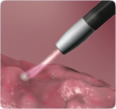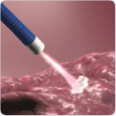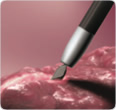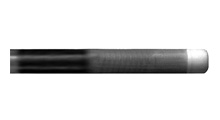ThermoStapler®
Argon
accessories & instruments
endoscopic irrigation pump - waterfall
smoke evacuation system - aria
Argon
efficiency oriented performance
 Argon coagulation uses the phenomenon of good conduction of high frequency current by ionized argon. Argon is a chemically inert gas, devoid of physiological effects and non combustible. Under the effect of current, it becomes ionized and forms a plasma cloud in which electric arcs are formed.
Argon coagulation uses the phenomenon of good conduction of high frequency current by ionized argon. Argon is a chemically inert gas, devoid of physiological effects and non combustible. Under the effect of current, it becomes ionized and forms a plasma cloud in which electric arcs are formed.
 In argon coagulation, there is no contact of the active electrode with the tissue, and the distance between the surgical instrument and the tissue in open surgery is up to about 5 mm, and in endoscopic surgery up to about 3 mm.
In argon coagulation, there is no contact of the active electrode with the tissue, and the distance between the surgical instrument and the tissue in open surgery is up to about 5 mm, and in endoscopic surgery up to about 3 mm.
The thermal effect occurs at the time when a spark jumps from the active electrode tip to the tissue. The length of the plasma arc between the probe tip and the tissue depends on the selected power, resistance of the target tissue and argon flow rate. Usually the distance between the active electrode and the tissue is 3 to 5 mm, depending on the selected coagulation parameters.
 When using argon coagulation, observe all precautions for standard monopolar coagulation. Read the instructions for using argon components. Class 4.8 (99.998%) or 5.0 (99.999%) argon is used for argon coagulation.
When using argon coagulation, observe all precautions for standard monopolar coagulation. Read the instructions for using argon components. Class 4.8 (99.998%) or 5.0 (99.999%) argon is used for argon coagulation.
efficiency oriented functions
- immediate hemostasis helps efficiently coagulate large areas of bleeding surface
- penetration depth limited to approximately 3 mm minimizes risk of perforation
- tissue carbonization is minimal compared to standard electrocoagulation
- no tissue vaporization minimizes the risk of perforation
- no contact between the applicator and tissue means no tissue adhesion
- less surgical smoke gives good visibility of operating area
- reduced smoke eliminates unpleasant odors
- precise application of thermal energy results in reducing procedure time
safety features
The main advantage of argon coagulation is constant, minimum depth of the thermal effect. Owing to the limited depth of tissue damage during argon plasma coagulation, the risk of perforation is minimized; therefore, this method can be safely used in thin walled organs.
As argon plasma is a good conductor, the desired effect is obtained with significantly less power compared to standard high voltage coagulation and the amount of heat delivered to the patient's tissues is lower.
download
Accessories & instruments



top


